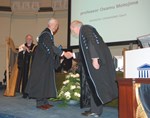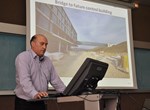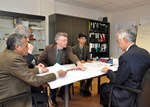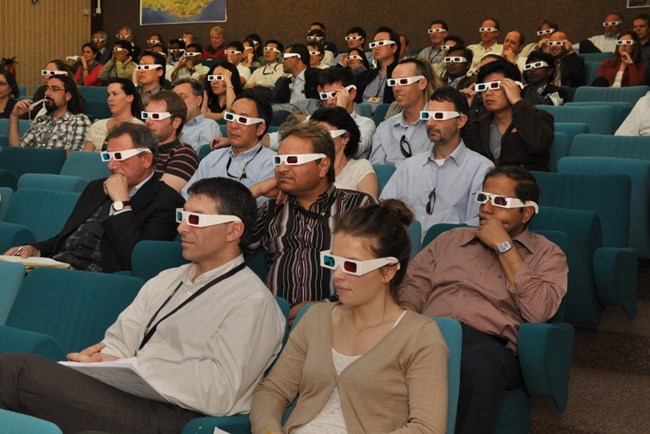It was an odd-looking procession that made its way through the ancient streets of Ghent last Friday. About 100 men and women lined up in twos and dressed in long black robes and velvet hats walking with great dignity towards the auditorium of the city's university, which was founded in 1817 by William I, King of the Netherlands. Today Ghent is the capital and largest city of Belgium's east Flanders region (see textbox).
The procession is part of a long-standing tradition that precedes Ghent University's dies natalis ceremony. Last week seven outstanding scientists, among them ITER Director-General Osamu Motojima, received the honorary doctorate degree. "ITER is a unique and highly challenging project," the head of the university's fusion branch and coordinator of the European fusion education program, Guido van Oost, said in his laudation, which he gave in Flemish. "Your determination has put the ITER train back on track. The torch that was lit thirty years ago by the first generation of fusion scientists is in good hands. By bringing a sun to Cadarache, you are working to shape a better future for our children and grandchildren, and for many generations to come."
In addition to the ITER Director-General, the honoris causa title was awarded to Paula Semer, presenter and producer of many emancipatory broadcasting programs and a Belgian "institution"; to Masatoshi Takeichi from the University in Kobe, Japan, for his pioneering work on the key role of specific intercellular adhesion in morphogenesis; to the Dutch researcher Désirée van der Heijde for pioneering work that has helped to improve the quality of life of patients suffering from rheumatoid arthritis; to Arnoud De Meyer, rector of the Singapore Management University; to Paul Sackett from the University of Minnesota, a leading authority in the field of human resources management; and finally to the Dutch researcher Saskia Sassen, author of the book The Global City, a highly original sociology of globalization.
The last word of the ceremony, the acceptance speech, was given by Arnoud De Meyer who thanked Ghent University and Rector Paul Van Cauwenberge on behalf of the seven laureates. "We are truly grateful for this honorary title which we also accept on behalf of our teams and—not to forget—our families. Without them a successful scientific career is not possible."
Click here to see the photo gallery of the event posted on the University of Ghent website.
|
Moving into a new office building can be as exciting as moving into a new house. You look at the blueprints, browse the photo albums and imagine how different your life—or work—will be in a new environment.
ITER staff members experienced some of this excitement last Thursday 29 March as Tim Watson, head of Buildings & Site Infrastructure, took the Inside ITER audience on a virtual tour of the new ITER Headquarters—part of it in 3D.
Tim started with the story of the building's genesis, beginning in 1998 when it was referred to as the Laboratory Office Building. It was originally designed to accommodate 750 people ... then it was "significantly shrunk" in 2004 to provide workspace for about 200 permanent and 100 visiting staff ... then resized again to fit ITER's anticipated needs, and budget.
The architectural approach has also changed over time. Back in 2004, the ITER Organization planned a no-thrill design, "comparable with [that of] industrial or commercial support facilities." Four years later, the tide had changed and a young and daring Marseille architect, Rudy Ricciotti, won the architectural competition organized by Agence Iter France and the European Domestic Agency.
The building Ricciotti and his local partner Laurent Bonhomme designed is functional with a touch of originality. All offices come with floor-to-ceiling windows; those on the northwest side opening to a magnificent landscape of wooded hills and Provençal villages, while those on the other side have a no-less-impressive view of the ITER installations.
Five-storey light shafts running the length of the building will bring natural light to every floor. A large wooden terrace, directly connected to the cafeteria, will offer the permanent temptation of a quick stroll or a coffee break.
The building will provide office space for 500 staff and contractors, but discussions are already ongoing about an extension for an extra 350 people.
Moving day is scheduled in October. Once the ITER Headquarters building is complete, no staff member or contractor will remain on the CEA site. ITER will be at home in its own enclosure, part of the staff moving to Headquarters, others to the present temporary office buildings.
Remote handling will be used to perform maintenance tasks on the machine and machine components; in a complex plant like ITER, this remote maintenance is fundamentally a manual activity. Operators in charge of remote handling operations will work from two dedicated areas on the ITER site: the Remote Handling Control Room for remote operations in and around the machine and the Hot Cell Operations Control Room for remote handling within the Hot Cell Facility.
The ITER maintenance campaigns will involve carrying out a set of tasks within a fixed period by the remote handling operations team. The policy of the Remote Handling Section is to organize the control rooms into standard work cells which can be easily configured for the execution of the particular tasks required for the shutdown.
Standardization in the remote handling control room is critical for the safe and efficient execution of remote handling operations. To promote standardization across a wide range of maintenance tasks, a contract was placed with Jacobs Engineering UK Limited for the implementation of a standard remote handling control room work cell. The effort, launched in July 2011, brought together specialists in remote handling (Oxford Technologies), robotics (Intermodalics), and human factors engineering (CCD, UK).
The standard work cell, which complies with ITER's high-level control system architecture, has been implemented in a dedicated room on the Oxford Technologies premises. To simulate operations, remote handling equipment controller software was developed according to the standard model with emulation of the control of real remote handling equipment. Wherever possible, recommended standard parts were used and validated in the work cell. Within this facility, the goal was to demonstrate that standard solutions can be applied to the ITER remote handling tasks; for each task demonstration, a wide variety of remote handling tools was simulated.
The standard work cell has been applied to execute three typical ITER remote handling tasks in simulation: the removal of the neutral beam cesium oven (demonstration of a neutral beam task); the de-contamination of a divertor cassette in a cleaning cell (demonstration of a Hot Cell Facility task); and the removal of a central divertor cassette (demonstration of an in-vessel task).
The simulations have shown that a standard remote handling work cell can be used for a range of ITER remote handling tasks. The team was able to demonstrate the viability of various standard parts: master arm, joysticks, emergency stops, virtual reality, communication middleware, and communication protocol. The standard work cell also demonstrated a workable layout that took "human factors engineering" into account.
The success of ITER operations will depend on the ability to remotely access and maintain critical components. This successful "proof-of-concept" work cell has demonstrated that ITER Organization standards are valid solutions for ITER remote handling.
The Max Planck Society is strengthening its commitment to the development of a sustainable energy supply and has joined forces with internationally renowned Princeton University to establish the Max Planck Princeton Research Centre for Plasma Physics.
Shirley M. Tilghman, the president of Princeton University, and Peter Gruss, president of the Max Planck Society, signed the agreement for the establishment of the new research centre on the Princeton University campus on 29 March 2012. On that occasion Peter Gruss stressed: "It is essential that we pool our strengths and knowledge in the field of fusion research in particular, so that we can develop nuclear fusion into something the world urgently needs for the years and decades to come: safe, clean and dependable energy technology."
The new centre's partners in the field of fusion research are the Max Planck Institute for Plasma Physics in Garching and Greifswald (IPP) and the Princeton Plasma Physics Laboratory (PPPL). In the field of astrophysical plasmas, the MPI for Solar System Research (Katlenburg-Lindau), the MPI for Astrophysics (Garching) and Princeton University's Department for Astrophysical Sciences are also involved. "The aim of the cooperation is to make greater use of the synergies between fusion research and the work carried out by the astrophysicists," explains Sibylle Günter, Director of the MPI for Plasma Physics. For example, it has emerged that many methods developed by fusion research are also applicable for astrophysics. It is also intended to apply insights into fusion and astrophysical plasmas to the further development of theoretical models, and thereby advance the research on fusion power as an energy source suitable for practical, everyday use.
Sibylle Günter from the MPI for Plasma Physics, Stewart Prager from the PPPL and Jim Stone from the Department for Astrophysical Sciences form the Leading Team of the Max Planck Princeton Centre. Also involved are IPP Directors Per Helander and Thomas Klinger, Sami Solanki from the Max Planck Institute for Solar System Research and Simon White from the Max Planck Institute for Astrophysics.
All of the partners on both the German and American sides have extensive experience in the fields of fusion research and astrophysics, and complement each other in different ways. The IPP is working on a tokamak experiment in Garching, which is based on the design of ITER. The IPP researchers are also building the Wendelstein 7-X Stellarator in Greifswald, and the PPPL has already contributed hardware for this project. Given that the PPPL is very interested in stellarator physics but is not carrying out an experiment of its own in this area, Günter assumes that this cooperation will intensify further with the establishment of the new centre. The PPPL, which is the leading institute in the field of fusion research in the US, operates a spherical tokamak and carries out laboratory experiments on general plasma physics, a topic that is also researched in Greifswald. The partners from the Max Planck Society and Princeton University would like to avail one another of their respective experimental systems and develop new theoretical models and codes in the context of the new centre.
The Max Planck Princeton Research Centre for Plasma Physics will promote the exchange of scientists, in particular junior scientists. To this effect, the scientists could cooperate on an experiment campaign at the corresponding institute or work jointly on the development of computer programs.
The new centre is one of ten Max Planck Centres that are currently being established at nine locations throughout the world.
|
A hot plasma is a bit like a star: it gives out light all across the electromagnetic spectrum, from radio waves all the way through X-rays to gamma rays.
When astrophysicists want to know what happens inside a star—how hot it is, what elements it is composed of—they use a spectrometer. A fusion physicist does exactly the same with a fusion plasma.
The light spectrum carries a considerable amount of information. Aim the proper spectrometer toward a region of the plasma and it will tell you how many impurities are present, how the temperature varies, and how fast the tenuous gas rotates.
The Edge Imaging X-ray Spectrometer that the Indian Domestic Agency will procure for ITER will be a valuable diagnostic tool. Last Wednesday, 28 March, the Procurement Arrangement documents were signed by Director-General Motojima; this Monday the documents will be countersigned by ITER-India Project Director Shishir Deshpande.
The Edge Imaging X-ray Spectrometer is one of three X-ray subsystems that will look at different regions of the ITER plasma in order to provide accurate measurements of their behaviour and performance. It is a vacuum-coupled, multi-channel device that sits behind a port plug and will have a very narrow, direct line of sight to the upper edge region of the D-shaped plasma.
This first diagnostics Procurement Arrangement signed with India is an exemplary one. The whole process was a close collaboration between ITER and the Indian Domestic Agency which sent several staff members for long periods to Cadarache, creating strong bonds between the institutions. "Working with the ITER team has been a great pleasure," says Sanjeev Varshney, technical responsible officer at the Indian Domestic Agency.
Dhiraj Bora, head of the Directorate for CODAC, Heating & Diagnostics, was present on Wednesday along with Diagnostics Division Head Mike Walsh, ITER Technical Responsible Officer Robin Barnsley, and one of the young Indian Domestic Agency staff members presently working at ITER, Dilshad Sulaiman.
With the decision to build ITER, the development of nuclear fusion a sustainable energy source has accelerated. The field attracts more and more engineers, perfectly capable of their engineering job, but often lacking the deeper insights into the broader fusion physics challenges at play. Opportunities for education and training are scarce and mainly focused upon the PhD level in university, or dedicated summer schools which addressed specific research issues.
With this in mind, the Fusion Academy offers a three-day crash course in the science and technology of nuclear fusion. In collaboration with Eindhoven University of Technology, the Fusion Academy has developed a unique program adapted to professionals in fusion R&D.
The course promotes interactive teaching and for that reason the group will be limited to 6-12 persons. The first event is scheduled for 20-22 June, 2012 near Eindhoven, the Netherlands. More information can be found at http://www.fusionacademy.eu/ or can be received by sending an email to: info@fusionacademy.eu.
|








